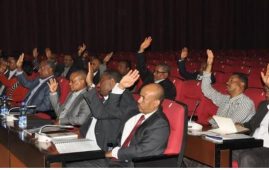Various media outlets have released negative reports concerning the construction of the Grand Ethiopian Renaissance Dam (GERD) over the past weeks. As usual, the comments on the impact of the Dam on downstream countries as well as on financial issues have been neither based on fact nor on accurate information. At a time when a relatively better understanding of the mutual benefits of the Grand Ethiopian Renaissance Dam, both for Ethiopia and the downstream countries, and of the aims of the Dam for members of the international community, is developing the continued fabrication of such stories tells a lot more about the never-ending nefarious campaign against the project than of the accuracy of the allegations.
construction of the Grand Ethiopian Renaissance Dam (GERD) over the past weeks. As usual, the comments on the impact of the Dam on downstream countries as well as on financial issues have been neither based on fact nor on accurate information. At a time when a relatively better understanding of the mutual benefits of the Grand Ethiopian Renaissance Dam, both for Ethiopia and the downstream countries, and of the aims of the Dam for members of the international community, is developing the continued fabrication of such stories tells a lot more about the never-ending nefarious campaign against the project than of the accuracy of the allegations.
The truth is The Grand Ethiopian Renaissance Dam is a project which will provide a lot of benefits to downstream countries and the region in general and additionally will be free of any negative environmental impact on the ecology of the Nile Basin. Indeed, the benefit of the GERD will come significantly from its role in mitigating climate change – several studies, including for example, the Intergovernmental Panel on Climate Change, have indicated that semi-arid and arid countries, like Egypt and Sudan, are likely to be more affected by Climate Change than temperate countries. A recent study commissioned by the Eastern Nile Technical Regional Office also concluded that water infrastructure development, or reservoir construction, was one of the five pillars identified for mitigating extreme hydrological events, as for example alternation of droughts and floods, likely to be caused by Climate Change.
The construction of GERD, in fact, is something that needs to be praised for its contribution to climate change mitigation. The GERD will also minimize evaporation loss from Dams located in unfavorable downstream desert settings. The evaporation loss from the planned full development of GERD is likely to be no more than 0.4 BCM contrary to highly exaggerated figures cited by some reports. In addition, a sustainable and regulated flow will ensure reliable all-season supply to downstream irrigation schemes, reducing harvest loss due to shortage of water during critical growing periods. It will also allow existing under-performing downstream hydroelectric power schemes to perform more effectively with more reliable, sediment-free, regular availability of water, making the building of new dams redundant. Increased power availability for the entire system in turn will enhance regional power trade among the three countries. In fact, all the claims on the environmental and social impacts are entirely misplaced.
Secondly, the fact that GERD is being constructed in an area where there are no significant human settlements and economic activities means the environmental and social impact of the projects will be insignificant or easily mitigated. It is also a less humid area, further underlining its environmentally friendliness, conserving the overall volume of water. Additionally, in relation to the impact on downstream countries, the accumulation of water in the Reservoir will not entail any consumptive withdrawal of water. In other words it will not limit the amount of water to downstream countries. Contrary to these claims, the GERD will offer multiple benefits to the downstream countries even under the current status quo. The design is flexible enough to allow the reservoir to fill without significantly affecting downstream operations. It might be added that most of the dams in downstream countries have silted up and lost over 50% of their storage capacity.
As a result, downstream hydraulic infrastructures, complemented by integrated watershed management, will benefit significantly from the construction of the GERD. The sediment reaching dams and water conveyance structures in Sudan and Egypt will be reduced from the day the first impoundment of water starts at the Dam. All this adds up to fostering confidence-building, laying a cornerstone for mutually beneficial and diversified trade and investment among the three countries, Ethiopia, Egypt and Sudan.
The latest deliberately hostile campaign efforts to denigrate the GERD relate to external support, and these are no more than long outdated tactics of political machination, trying to revive mistrust by attempting to resurrect old fault lines. The truth is GERD is and will be completed through the contribution of the Ethiopian people and government. The demagogic claim that alleging some countries are contributing behind the scenes is simply rubbish. The financing mechanism of the Grand Ethiopian Renaissance Dam, entirely based on home finance, is transparent. It has brought together tens of millions of Ethiopians irrespective of their ethnic, religious, political persuasion or background. Ethiopians at home and abroad are contributing zealously to build their dam, a project of which they are the sole financiers. The National Committee had raised over seven billion birr in the past year. This was due to the determination of the public to build the dam through their collective financial effort. They have demonstrated this by their enthusiastic participation in public bond sales and other contributions. The project performance over the past year has been very satisfactory. The Committee is now designing various mechanisms to continue to mobilize the finance needed for the completion of the project. Other claims to the contrary, and these latest allegations, are no more than another hoax in a continuous campaign against the interests of the Ethiopian people.
****************
* Originally published on A Week in the Horn of the Ministry of Foreign Affairs – on March 15, 2013 issue, titled “The hostile campaign against GERD: more old wine in new bottles”. Items from A Week in the Horn are re-published here with a permission to do so.
Check the archive for related posts.






Comments are closed.
Leave a Comment